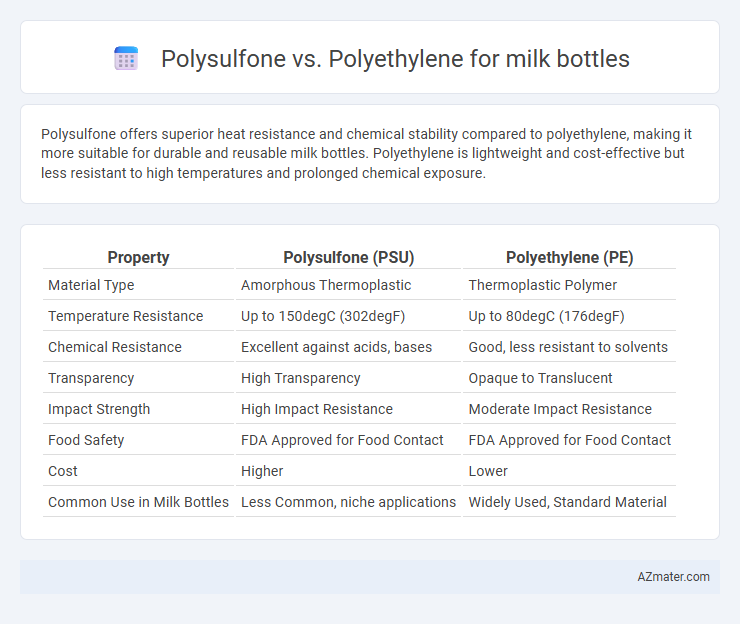Polysulfone offers superior heat resistance and chemical stability compared to polyethylene, making it more suitable for durable and reusable milk bottles. Polyethylene is lightweight and cost-effective but less resistant to high temperatures and prolonged chemical exposure.
Table of Comparison
| Property | Polysulfone (PSU) | Polyethylene (PE) |
|---|---|---|
| Material Type | Amorphous Thermoplastic | Thermoplastic Polymer |
| Temperature Resistance | Up to 150degC (302degF) | Up to 80degC (176degF) |
| Chemical Resistance | Excellent against acids, bases | Good, less resistant to solvents |
| Transparency | High Transparency | Opaque to Translucent |
| Impact Strength | High Impact Resistance | Moderate Impact Resistance |
| Food Safety | FDA Approved for Food Contact | FDA Approved for Food Contact |
| Cost | Higher | Lower |
| Common Use in Milk Bottles | Less Common, niche applications | Widely Used, Standard Material |
Introduction to Polysulfone and Polyethylene
Polysulfone is a high-performance thermoplastic known for its excellent thermal stability, chemical resistance, and durability, making it suitable for repeated use in applications like milk bottles. Polyethylene, particularly high-density polyethylene (HDPE), is widely used for milk packaging due to its lightweight, impact resistance, and cost-effectiveness. Both materials offer distinct advantages, with polysulfone providing superior strength and reusability, while polyethylene remains popular for disposable or single-use milk bottles due to its ease of processing and recyclability.
Chemical Structure and Composition
Polysulfone features an aromatic backbone with sulfone groups (-SO2-) that provide high thermal stability and chemical resistance, making it suitable for repeated sterilization in milk bottles. Polyethylene, composed of long chains of ethylene monomers (-CH2-CH2-) with a simple hydrocarbon structure, offers excellent flexibility and moisture barrier but limited heat resistance compared to polysulfone. The presence of polar sulfone groups in polysulfone enhances durability against harsh detergents, whereas polyethylene's non-polar structure limits its resistance to solvents and high temperatures.
Mechanical Strength and Durability
Polysulfone offers superior mechanical strength and durability compared to polyethylene, making it more resistant to impact and deformation under stress, which is crucial for milk bottles requiring long-term reuse and sterilization. While polyethylene is lightweight and cost-effective, it tends to have lower tensile strength and can degrade faster when exposed to heat and repeated cleaning cycles. The higher glass transition temperature of polysulfone ensures enhanced dimensional stability and chemical resistance, extending the lifespan of milk bottles in demanding environments.
Temperature Resistance and Thermal Stability
Polysulfone offers superior temperature resistance and thermal stability compared to polyethylene, withstanding continuous use temperatures up to 150degC without degrading, making it ideal for hot milk storage or sterilization processes. Polyethylene typically withstands temperatures up to 80-90degC before softening, limiting its application for hot liquids and repeated heat exposure. The high glass transition temperature and excellent thermal endurance of polysulfone ensure minimal deformation and prolonged durability in high-temperature environments, whereas polyethylene may warp or lose structural integrity under similar conditions.
Safety and Food Contact Approvals
Polysulfone offers superior thermal stability and chemical resistance compared to polyethylene, making it safer for repeated use in milk bottles under varying temperature conditions. It is approved by regulatory agencies such as the FDA for food contact applications due to its non-toxic and BPA-free composition, ensuring no harmful leachates into milk. Polyethylene, commonly used in milk bottles, is also FDA-approved and generally safe, but it has lower heat resistance and may degrade faster with frequent cleaning and sterilization.
Weight and Flexibility Comparison
Polysulfone offers higher thermal stability and strength but is generally heavier and less flexible than polyethylene when used in milk bottles. Polyethylene, known for its lightweight properties and excellent flexibility, provides easier handling and better resistance to impact under cold storage conditions. This makes polyethylene a preferred choice for consumer-friendly milk bottles where weight and flexibility are critical factors.
Transparency and Aesthetic Appeal
Polysulfone offers superior transparency compared to polyethylene, making it an excellent choice for milk bottles where clear visibility of the contents is desired. Its high-gloss finish enhances aesthetic appeal, providing a sleek and modern look that polyethylene, with its typically opaque or translucent appearance, cannot match. These properties make polysulfone preferable for consumers who prioritize both visual clarity and design elegance in milk packaging.
Cost Efficiency in Manufacturing
Polysulfone offers superior thermal resistance and durability for milk bottle manufacturing but comes at a higher raw material and processing cost compared to polyethylene. Polyethylene remains the most cost-efficient option due to its lower material price, ease of molding, and faster production cycles in large-scale milk bottle production. Manufacturers prioritize polyethylene when balancing cost efficiency and adequate performance for disposable or short-term use milk bottles.
Environmental Impact and Recyclability
Polysulfone exhibits higher durability and heat resistance compared to polyethylene, resulting in longer-lasting milk bottles with less frequent replacement, which can reduce overall environmental waste. Polyethylene, widely used for milk bottles, is more recyclable in existing municipal systems, making its environmental impact potentially lower when proper recycling is implemented. The environmental footprint of polysulfone is greater due to energy-intensive production processes and limited recycling infrastructure, while polyethylene's widespread recyclability supports a more circular lifecycle in packaging applications.
Conclusion: Choosing the Best Material for Milk Bottles
Polysulfone offers superior heat resistance, chemical stability, and durability, making it ideal for repeated sterilization and long-term use in milk bottles. Polyethylene excels in cost-effectiveness and flexibility but has lower temperature tolerance and can absorb flavors over time. For milk bottles requiring durability and safety under high temperatures, polysulfone is the best choice, while polyethylene suits short-term or disposable applications.

Infographic: Polysulfone vs Polyethylene for Milk bottle
 azmater.com
azmater.com